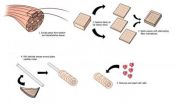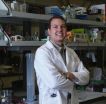(Press-News.org) MEDFORD/SOMERVILLE, Mass. (December, 26 2012) – Tufts University School of Engineering researchers have developed a novel method for fabricating collagen structures that maintains the collagen's natural strength and fiber structure, making it useful for a number of biomedical applications.
Collagen, the most abundant protein in the body, is widely used to build scaffolds for tissue engineering because it is biocompatible and biodegradable. Collagen is, however, hard to work with in its natural form because it is largely insoluble in water, and common processing techniques reduce its strength and disrupt its fibrous structure.
The Tufts engineers' new technique, called bioskiving, creates collagen structures from thin sheets of decellularized tendon stacked with alternating fiber directions that maintain much of collagen's natural strength.
Bioskiving does not dilute collagen's natural properties, says Qiaobing Xu, assistant professor of biomedical engineering, and inventor of the new technique. "Our method leverages collagen's native attributes to take advantage of the well-organized micro/nanostructures that nature already provides," he says.
Xu and Kyle Alberti, a Ph.D. student in Xu's lab, describe their technology in the paper "Slicing, Stacking and Rolling: Fabrication of Nanostructured Collagen Constructs from Tendon Sections" published online in Advanced Healthcare Materials on December 12, 2012.
Slice, Stack, and Roll
In their research, Xu and Albert cut small sections of collagen from bovine tendons. Using a specialized detergent, the researchers decellularized the sections, leaving intact only the extracellular collagen matrix made of bundles of aligned collagen nanofibers.
Xu and Alberti sliced the sections into ultra-thin sheets using a microtome, and then stacked 10 slices, crisscrossing the sheets so that the fibers in one ran perpendicular to those above and below it. This process produced a scaffold material with tensile strength stronger than constructs made using common processing techniques, Xu notes.
The researchers also created tubular scaffolding by rolling layers of collagen sheets around Teflon-coated glass rods. The sheets were layered so that fibers ran along the length and the circumference of the rods. This process yielded tubes that were found to be stronger than similar tubes made of reconstituted collagen. They also maintained their highly aligned fiber structure.
"Alignment gives the scaffold the ability to guide the direction and orientation of cell growth," says Xu, who also has a faculty appointment at Tufts School of Medicine, "This capability is beneficial for tissue engineering applications where biocompatibility and the ability to guide unidirectional nerve growth are both desired, such as prosthetic or tissue engineering-based blood vessels or nerve conduits."
INFORMATION:
The work was supported by funding from a Tufts Faculty Research Award, the Charlton Award from Tufts School of Medicine, and a Tufts Neuroscience Institute Pilot Grant. It utilized facilities at the Harvard University Center for Nanoscale Systems(CNS), a member of the National Nanotechnology Infrastructure Network (NNIN), which is supported by the National Science Foundation under NSF award no. ECS-0335765.
Alberti, K. A. and Xu, Q. (2012), Slicing, Stacking and Rolling: Fabrication of Nanostructured Collagen Constructs from Tendon Sections. Advanced Healthcare Materials. doi: 10.1002/adhm.201200319
Tufts University School of Engineering, located on Tufts' Medford/Somerville campus, the School of Engineering offers a rigorous engineering education in a unique environment that blends the intellectual and technological resources of a world-class research university with the strengths of a top-ranked liberal arts college. Close partnerships with Tufts' excellent undergraduate, graduate and professional schools, coupled with a long tradition of collaboration, provide a strong platform for interdisciplinary education and scholarship. The School of Engineering's mission is to educate engineers committed to the innovative and ethical application of science and technology in addressing the most pressing societal needs, to develop and nurture twenty-first century leadership qualities in its students, faculty, and alumni, and to create and disseminate transformational new knowledge and technologies that further the well-being and sustainability of society in such cross-cutting areas as human health, environmental sustainability, alternative energy, and the human-technology interface.
Slice, stack, and roll: A new way to build collagen scaffolds
New scaffolds are stronger and direct cell growth more effectively
2012-12-28
ELSE PRESS RELEASES FROM THIS DATE:
GSA Bulletin celebrates GSA's 125th Anniversary with new geologic time scale
2012-12-28
Boulder, Colo., USA – GSA BULLETIN articles posted online between 10 Dec. and 21 Dec. 2012 include a new version of The Geological Society of America's Geologic Time Scale. This paper marks the beginning of a special series of invited papers in celebration of GSA's 125th Anniversary in 2013. Highlights are provided below.
1. A new/revised GSA geologic time scale.
2. Complex mammal fossil record of the Gran Barranca, Patagonia, Argentina.
3. A new and simple method for estimating the rate of sediment delivery to ancient basins.
4. A study of the provenance of volcanic ...
Monkey see, monkey do: Visual feedback is necessary for imitating facial expressions
2012-12-28
Research using new technology shows that our ability to imitate facial expressions depends on learning that occurs through visual feedback.
Studies of the chameleon effect confirm what salespeople, tricksters, and Lotharios have long known: Imitating another person's postures and expressions is an important social lubricant.
But how do we learn to imitate with any accuracy when we can't see our own facial expressions and we can't feel the facial expressions of others?
Richard Cook of City University London, Alan Johnston of University College London, and Cecilia Heyes ...
Strange behavior: New study exposes living cells to synthetic protein
2012-12-28
One approach to understanding components in living organisms is to attempt to create them artificially, using principles of chemistry, engineering and genetics. A suite of powerful techniques—collectively referred to as synthetic biology—have been used to produce self-replicating molecules, artificial pathways in living systems and organisms bearing synthetic genomes.
In a new twist, John Chaput, a researcher at Arizona State University's Biodesign Institute and colleagues at the Department of Pharmacology, Midwestern University, Glendale, AZ have fabricated an artificial ...
Penn team developing new class of malaria drugs using essential calcium enzyme
2012-12-28
PHILADELPHIA - Calpain, a calcium-regulated enzyme, is essential to a host of cellular processes, but can cause severe problems in its overactivated state. It has been implicated as a factor in muscular dystrophy, AIDS, Alzheimer's disease, multiple sclerosis, and cancer. As such, finding and exploiting calpain inhibitors is an important area of research.
A team from the Perelman School of Medicine, University of Pennsylvania, in collaboration with the University of California at San Francisco and the Department of Biochemistry and Protein Function Discovery at Queen's ...
Vanderbilt study examines Affordable Care Act's impact on uncompensated care
2012-12-28
Nashville (Tenn.) - The decision by several states not to expand Medicaid health insurance for the poor may create unintended cuts for hospitals that provide uncompensated care, according to a study by John Graves, Ph.D., a Vanderbilt policy expert in the Department of Preventive Medicine.
Graves used financial data from U.S. hospitals and insurance data in each state to predict cuts in Medicare and Medicaid disproportionate share (DSH) funds paid to the nearly three-fourths of U.S. hospitals that serve low-income patients. The results, published in the Dec. 20 issue ...
Penn team mimicking a natural defense against malaria to develop new treatments
2012-12-28
PHILADELPHIA - One of the world's most devastating diseases is malaria, responsible for at least a million deaths annually, despite global efforts to combat it. Researchers from the Perelman School of Medicine at the University of Pennsylvania, working with collaborators from Drexel University, The Children's Hospital of Philadelphia, and Johns Hopkins University, have identified a protein in human blood platelets that points to a powerful new weapon against the disease. Their work was published in this months' issue of Cell Host and Microbe.
Malaria is caused by parasitic ...
2 new species of orchid found in Cuba
2012-12-28
Researchers from the University of Vigo, in collaboration with the Environmental Services Unit at the Alejandro de Humboldt National Park (Cuba), have discovered two new species of Caribbean orchid.
The Caribbean islands have been natural laboratories and a source of inspiration for biologists for over two centuries now. Suffice to say that the studies by Charles Darwin and Alfred Russel Wallace in the tropical archipelagos contributed to the emergence of the theory of evolution.
In this case, a Spanish research team from the University of Vigo has discovered two new ...
Broader background checks and denial criteria could help prevent mass shooting catastrophes
2012-12-28
UC Davis Health System is improving lives and transforming health care by providing excellent patient care, conducting groundbreaking research, fostering innovative, interprofessional education, and creating dynamic, productive partnerships with the community. The academic health system includes one of the country's best medical schools, a 619-bed acute-care teaching hospital, a 1000-member physician's practice group and the new Betty Irene Moore School of Nursing. It is home to a National Cancer Institute-designated comprehensive cancer center, an international neurodevelopmental ...
Trying to halt hepatitis C's molecular hijacking
2012-12-28
AURORA, Colo. (Dec. 27, 2012) – Researchers at the University of Colorado School of Medicine have figured out intimate details of how the hepatitis C virus takes over an invaded cell, a breakthrough that could point to way for new treatments for the virus.
Hep C hijacks the machinery by which a cell makes proteins and uses it instead to create proteins for the virus. Over the last two decades, researchers have figured out that Hep C uses an RNA molecule to do this. Now they're trying to fill in the details.
One key detail is reported in a paper published online Dec. ...
Rush University Medical Center scientists home in on cause of osteoarthritis pain
2012-12-28
(CHICAGO)--Researchers at Rush University Medical Center, in collaboration with researchers at Northwestern University, have identified a molecular mechanism central to the development of osteoarthritis (OA) pain, a finding that could have major implications for future treatment of this often-debilitating condition.
"Clinically, scientists have focused on trying to understand how cartilage and joints degenerate in osteoarthritis. But no one knows why it hurts," said Dr. Anne-Marie Malfait, associate professor of biochemistry and of internal medicine at Rush, who led ...
LAST 30 PRESS RELEASES:
Tracing the quick synthesis of an industrially important catalyst
New software sheds light on cancer’s hidden genetic networks
UT Health San Antonio awarded $3 million in CPRIT grants to bolster cancer research and prevention efforts in South Texas
Third symposium spotlights global challenge of new contaminants in China’s fight against pollution
From straw to soil harmony: International team reveals how biochar supercharges carbon-smart farming
Myeloma: How AI is redrawing the map of cancer care
Manhattan E. Charurat, Ph.D., MHS invested as the Homer and Martha Gudelsky Distinguished Professor in Medicine at the University of Maryland School of Medicine
Insilico Medicine’s Pharma.AI Q4 Winter Launch Recap: Revolutionizing drug discovery with cutting-edge AI innovations, accelerating the path to pharmaceutical superintelligence
Nanoplastics have diet-dependent impacts on digestive system health
Brain neuron death occurs throughout life and increases with age, a natural human protein drug may halt neuron death in Alzheimer’s disease
SPIE and CLP announce the recipients of the 2025 Advanced Photonics Young Innovator Award
Lessons from the Caldor Fire’s Christmas Valley ‘Miracle’
Ant societies rose by trading individual protection for collective power
Research reveals how ancient viral DNA shapes early embryonic development
A molecular gatekeeper that controls protein synthesis
New ‘cloaking device’ concept to shield sensitive tech from magnetic fields
Researchers show impact of mountain building and climate change on alpine biodiversity
Study models the transition from Neanderthals to modern humans in Europe
University of Phoenix College of Doctoral Studies releases white paper on AI-driven skilling to reduce burnout and restore worker autonomy
AIs fail at the game of visual “telephone”
The levers for a sustainable food system
Potential changes in US homelessness by ending federal support for housing first programs
Vulnerability of large language models to prompt injection when providing medical advice
Researchers develop new system for high-energy-density, long-life, multi-electron transfer bromine-based flow batteries
Ending federal support for housing first programs could increase U.S. homelessness by 5% in one year, new JAMA study finds
New research uncovers molecular ‘safety switch’ shielding cancers from immune attack
Bacteria resisting viral infection can still sink carbon to ocean floor
Younger biological age may increase depression risk in older women during COVID-19
Bharat Innovates 2026 National Basecamp Showcases India’s Most Promising Deep-Tech Ventures
Here’s what determines whether your income level rises or falls
[Press-News.org] Slice, stack, and roll: A new way to build collagen scaffoldsNew scaffolds are stronger and direct cell growth more effectively




